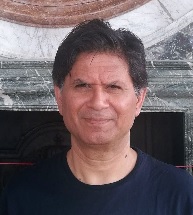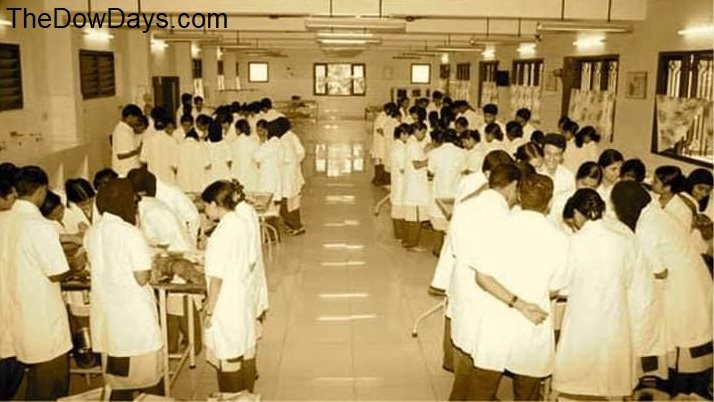By Dr. Jamshed Bashir
DMC Class of 1986

Starting with an old bland vignette reminiscing dissection of cadavers when we started in Dow Medical College. It is part of a series of essays I wrote about my time in the college.

Like all new medical students we were excited to go to the ‘dissection hall’, a large cavernous room with tables in two rows, embalmed bodies splayed on each. A stench of Formaldehyde filled the hall, which grew stronger as we approached our designated ‘body’. We didn’t refer to them as ‘cadavers’, or laash (Urdu), but used a neutral description, ‘body’, as if it was non-human plastic model, something we later did receive for students who were squeamish, or wanted to revise at times when there were no ‘bodies’.
All of us had been allocated roll numbers based on our pre-medical marks at the time of our admission. As the total number of students was in excess of 400, girls less than half, as there was a gender quota which was later abolished, leading to an overwhelming imbalance in favour of the girls due to their better academic achievements, reflected in scores. The groups were A, B and C further subdivided into 1, 2, 3 and 4. I was a lowly C3, a group which was mockingly referred to as ‘C ke mailay’ (dirt bags of C) by some students of groups A or B, with better grades. There was only a limited number of ‘bodies’, I think 12, but it depended on the supply. The ‘unwilling donors of bodies’ were people who had died either by accident or disease and did not have a relative to claim their corpse for burial. These unclaimed (la-vaaris) bodies were used to teach anatomy to the students. Abdul Sattar Edhi was not very well known at that time but many of us had heard his name, as his charity came to snatch the unclaimed bodies for burial, rather than let us use them for dissection, which he probably thought of as an act of desecration.
Group C was allocated lower limb to dissect, whereas B had the upper limb. So even if others didn’t ask which group one belonged to, they could simply tell by looking at the region one was dissecting or observing, as most of the students watched, while only one brave soul did the actual dissection to expose the muscles, arteries and veins following the Atlas of Anatomy, or another manual. There were some who followed Grey’s Anatomy, recognised as the Bible of anatomy for several decades. My friend Fakhri was one such scholar. He memorised almost the whole book and could quote chapter and verse, even the page number, if asked. I do not remember Fakhri ever soiling his hands with the actual dissection, but there were others like Arif Rasheed who hit the ground running and dissected the whole upper limb within a couple of days, torn and stapled relevant sections of Grey’s Anatomy by their side, neatly displaying all structures, courses of the main nerves, blood vessels, origin and insertion of the muscles, knew their actions and the bones they were attached to.
When I approached our allocated ‘body’, I noticed it was a healthy tall man who must have died of some neck injury, as there was a large laceration on the right side of the neck and there were millions of maggots wriggling around in the wide open wound. We were horrified and repulsed in equal measure and hurriedly called Shabu, the erstwhile curator and trouble-shooter of the Dissection Hall. He looked at it casually and said that we should get on with the lower limb, as that area was unaffected. ‘I will try to get you another body’, he added helpfully, ‘but it depends on the supply’. We touched the lower limb and half-heartedly did some dissection, notwithstanding the strong eye-watering stink of Formaldehyde, using our bare hands, which were soon greasy with human fat. I do not remember wearing any gloves, let alone face masks.There were a couple of ‘seniors’ who helped the new students with short tutorials, as the official lecturers and demonstrators were hardly seen, or at least I don’t remember seeing them. One of the ubiquitous ‘seniors’ was X, a year ahead of us, short thin, with thick glasses and a moustache. He was very popular with the girls, teaching in Urdu but not that helpful to the boys. Soon we found out that he was not very knowledgeable either and as far as I remember, flunked his Anatomy exams later, which was ironical. He was actually a canvasser for Jamiat, using tutorials as bait, which was a fairly common ploy, we soon found out. I remember Mohsin Kamal, a friend from St Jude’s, stood beside the cadaver one day, his eyes closed waving his hands over the leg in the air. I asked him what was he doing? ‘Just trying to revise the course of Femoral Nerve’, he saidThere was a chap sat there dissecting the lower limb, as we spoke. Upon hearing us, he pointed to the leg and helpfully explained, , ‘Here you are, this is the trunk of the nerve I have exposed earlier…’Before he could say anything more, Mohsin quipped, ‘Please stop. Don’t show me anything, my concept would be ruined (mera concept kharaab ho jaaega)’. I laughed, but Mohsin was undaunted. He continued the revision with his eyes shut, standing next to the cadaver. We used to joke later that sometimes our ‘concepts’ cannot withstand the harsh realities of life:-)
There was a viva after a couple of months to test our knowledge of anatomy. I got ordinary scores, but some of the class fellows immediately made their mark, like Arif Hakim, Asif Rasheed, Niaz Ahmad, Jamshed Akhter, Nahid Rizvi, Pervez Shaikh, Amina Jabeen, Fakhri making the rest of us regard them with respect. Later on when it came to head and neck, I got the highest marks (42/50) which surprised many colleagues. Even I was shocked. By then everyone had a measure of each other, the brighter ones breaking off the rest of hoi polloi like me. I had bought an American textbook, Snell’s Anatomy by then, instead of using Grey’s and that is my excuse for my better scores. In the following viva on abdomen and pelvis, my marks were good again, not the highest, but reasonable (36/50). I am afraid I did not replicate my scores in the final exams, which included written papers and viva, not only in general anatomy but embryology and histology as well, both of which did not interest me that much. In fact embryology was a completely strange subject, which I found difficult to engage with, as there was no reason why things were occurring, tissues differentiating, mesoderm-epithelial interactions, novel growth factors. What was driving the changes, how were things moving immaculately and linearly, leading to a fully formed foetus? It was all a fascinating mystery, creating more questions than were addressed. We memorised it without knowing too much of ‘why’. There was a professor from Sindh Medical College, Kashf ud Duja, who was requested to come to deliver a few lectures close to our final exams as Prof Waheed’s lectures on Embryology were deemed to be too difficult for average students to digest and comprehend.
